The Opioid Crisis in America: Causes, Impacts, and Alternatives
VerifiedAdded on 2022/08/11
|5
|1127
|18
Essay
AI Summary
This essay provides an overview of the opioid crisis in the United States. It begins by defining opioids and highlighting their dual nature as both pain relievers and potential drugs of abuse, including heroin. The essay then examines the scope of the crisis, citing statistics on opioid misuse and addiction, and discusses the impact on individuals, families, and communities. It explores the role of nurse practitioners in addressing the crisis and the challenges they face. Furthermore, the essay identifies alternative pain management strategies, such as acetaminophen, aspirin, and NSAIDs, which can be used to reduce reliance on opioids. The conclusion emphasizes the need for controlled opioid prescriptions to mitigate misuse and the importance of taking action to benefit both users and healthcare professionals. The references provide sources for the information presented.
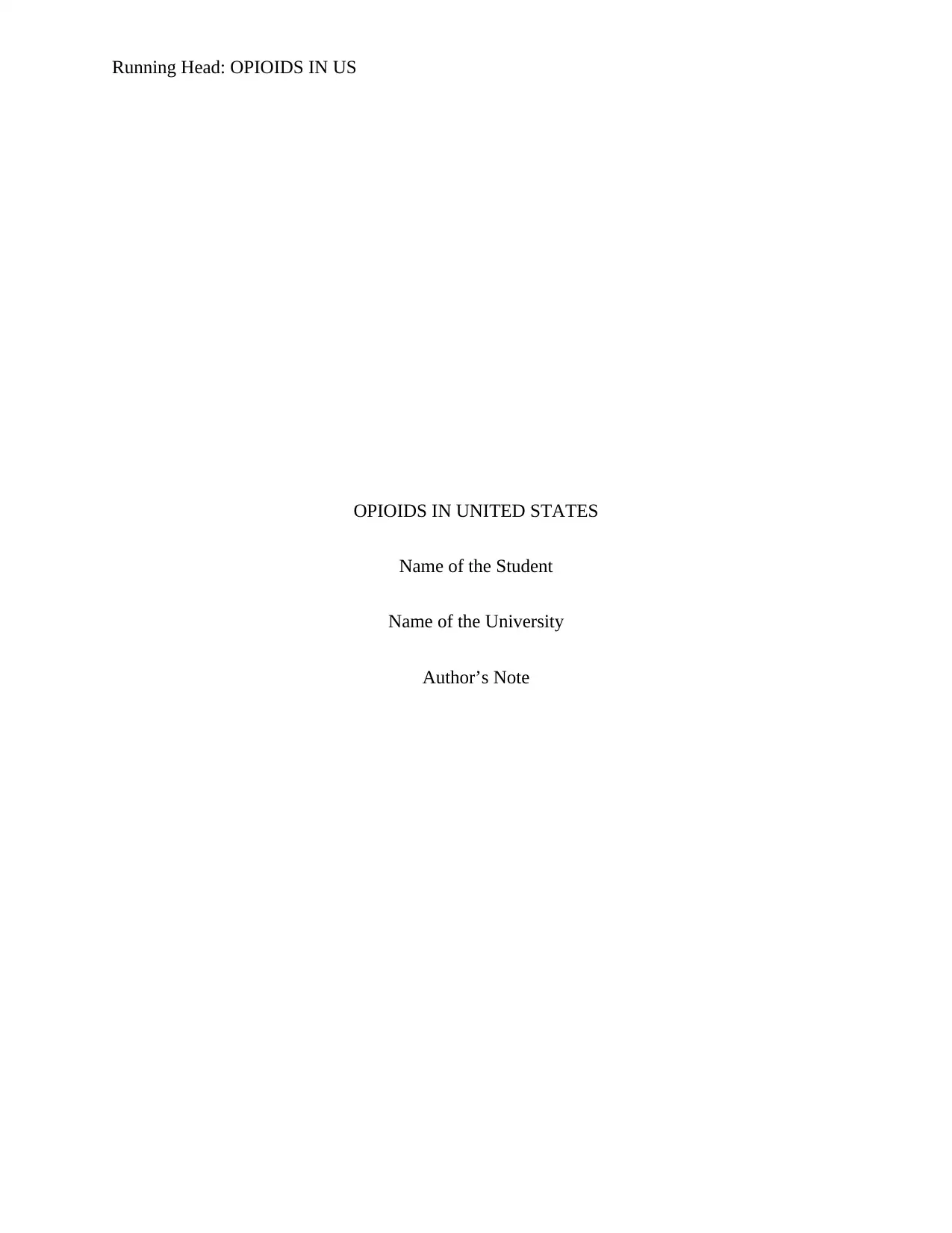
Running Head: OPIOIDS IN US
OPIOIDS IN UNITED STATES
Name of the Student
Name of the University
Author’s Note
OPIOIDS IN UNITED STATES
Name of the Student
Name of the University
Author’s Note
Paraphrase This Document
Need a fresh take? Get an instant paraphrase of this document with our AI Paraphraser
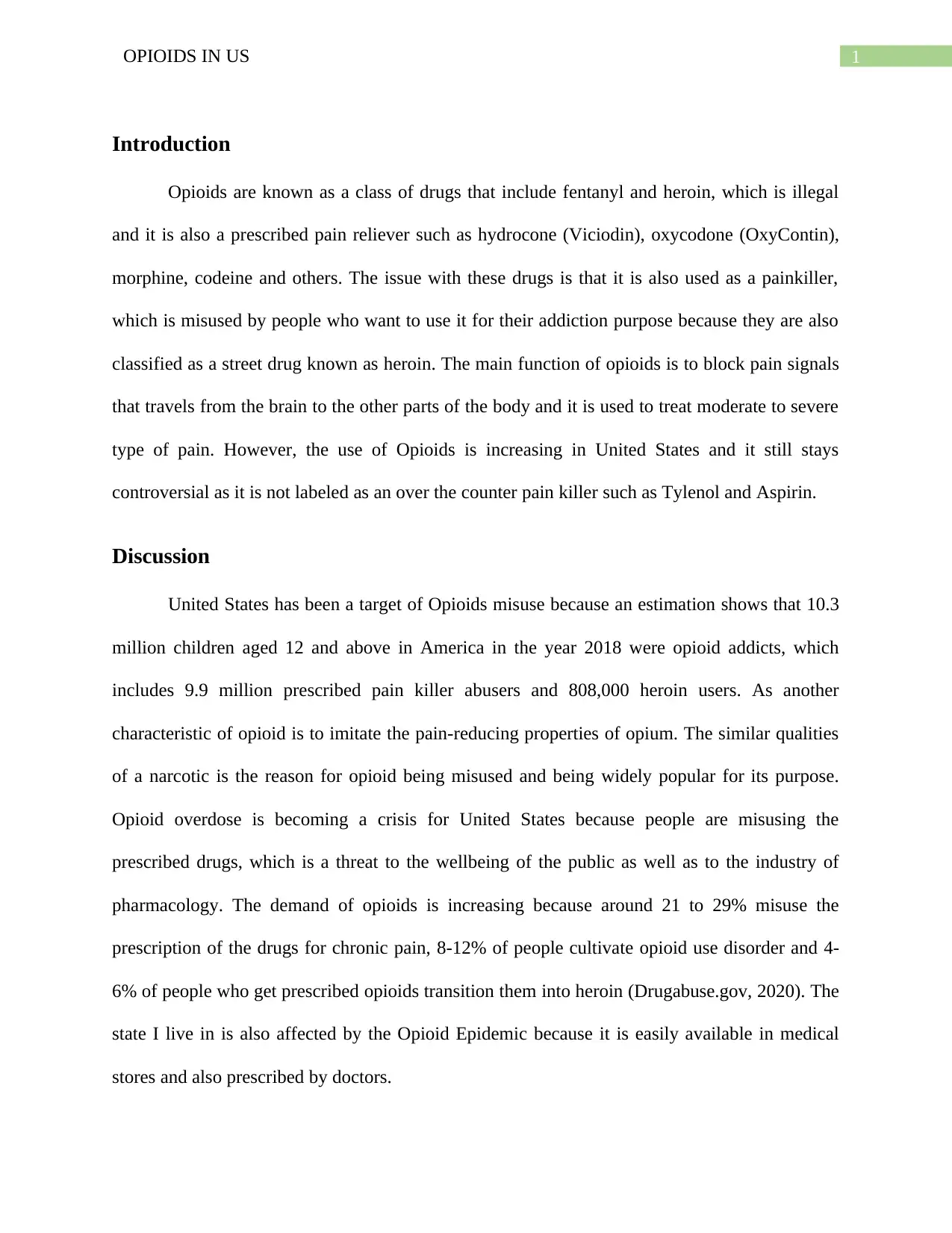
1OPIOIDS IN US
Introduction
Opioids are known as a class of drugs that include fentanyl and heroin, which is illegal
and it is also a prescribed pain reliever such as hydrocone (Viciodin), oxycodone (OxyContin),
morphine, codeine and others. The issue with these drugs is that it is also used as a painkiller,
which is misused by people who want to use it for their addiction purpose because they are also
classified as a street drug known as heroin. The main function of opioids is to block pain signals
that travels from the brain to the other parts of the body and it is used to treat moderate to severe
type of pain. However, the use of Opioids is increasing in United States and it still stays
controversial as it is not labeled as an over the counter pain killer such as Tylenol and Aspirin.
Discussion
United States has been a target of Opioids misuse because an estimation shows that 10.3
million children aged 12 and above in America in the year 2018 were opioid addicts, which
includes 9.9 million prescribed pain killer abusers and 808,000 heroin users. As another
characteristic of opioid is to imitate the pain-reducing properties of opium. The similar qualities
of a narcotic is the reason for opioid being misused and being widely popular for its purpose.
Opioid overdose is becoming a crisis for United States because people are misusing the
prescribed drugs, which is a threat to the wellbeing of the public as well as to the industry of
pharmacology. The demand of opioids is increasing because around 21 to 29% misuse the
prescription of the drugs for chronic pain, 8-12% of people cultivate opioid use disorder and 4-
6% of people who get prescribed opioids transition them into heroin (Drugabuse.gov, 2020). The
state I live in is also affected by the Opioid Epidemic because it is easily available in medical
stores and also prescribed by doctors.
Introduction
Opioids are known as a class of drugs that include fentanyl and heroin, which is illegal
and it is also a prescribed pain reliever such as hydrocone (Viciodin), oxycodone (OxyContin),
morphine, codeine and others. The issue with these drugs is that it is also used as a painkiller,
which is misused by people who want to use it for their addiction purpose because they are also
classified as a street drug known as heroin. The main function of opioids is to block pain signals
that travels from the brain to the other parts of the body and it is used to treat moderate to severe
type of pain. However, the use of Opioids is increasing in United States and it still stays
controversial as it is not labeled as an over the counter pain killer such as Tylenol and Aspirin.
Discussion
United States has been a target of Opioids misuse because an estimation shows that 10.3
million children aged 12 and above in America in the year 2018 were opioid addicts, which
includes 9.9 million prescribed pain killer abusers and 808,000 heroin users. As another
characteristic of opioid is to imitate the pain-reducing properties of opium. The similar qualities
of a narcotic is the reason for opioid being misused and being widely popular for its purpose.
Opioid overdose is becoming a crisis for United States because people are misusing the
prescribed drugs, which is a threat to the wellbeing of the public as well as to the industry of
pharmacology. The demand of opioids is increasing because around 21 to 29% misuse the
prescription of the drugs for chronic pain, 8-12% of people cultivate opioid use disorder and 4-
6% of people who get prescribed opioids transition them into heroin (Drugabuse.gov, 2020). The
state I live in is also affected by the Opioid Epidemic because it is easily available in medical
stores and also prescribed by doctors.
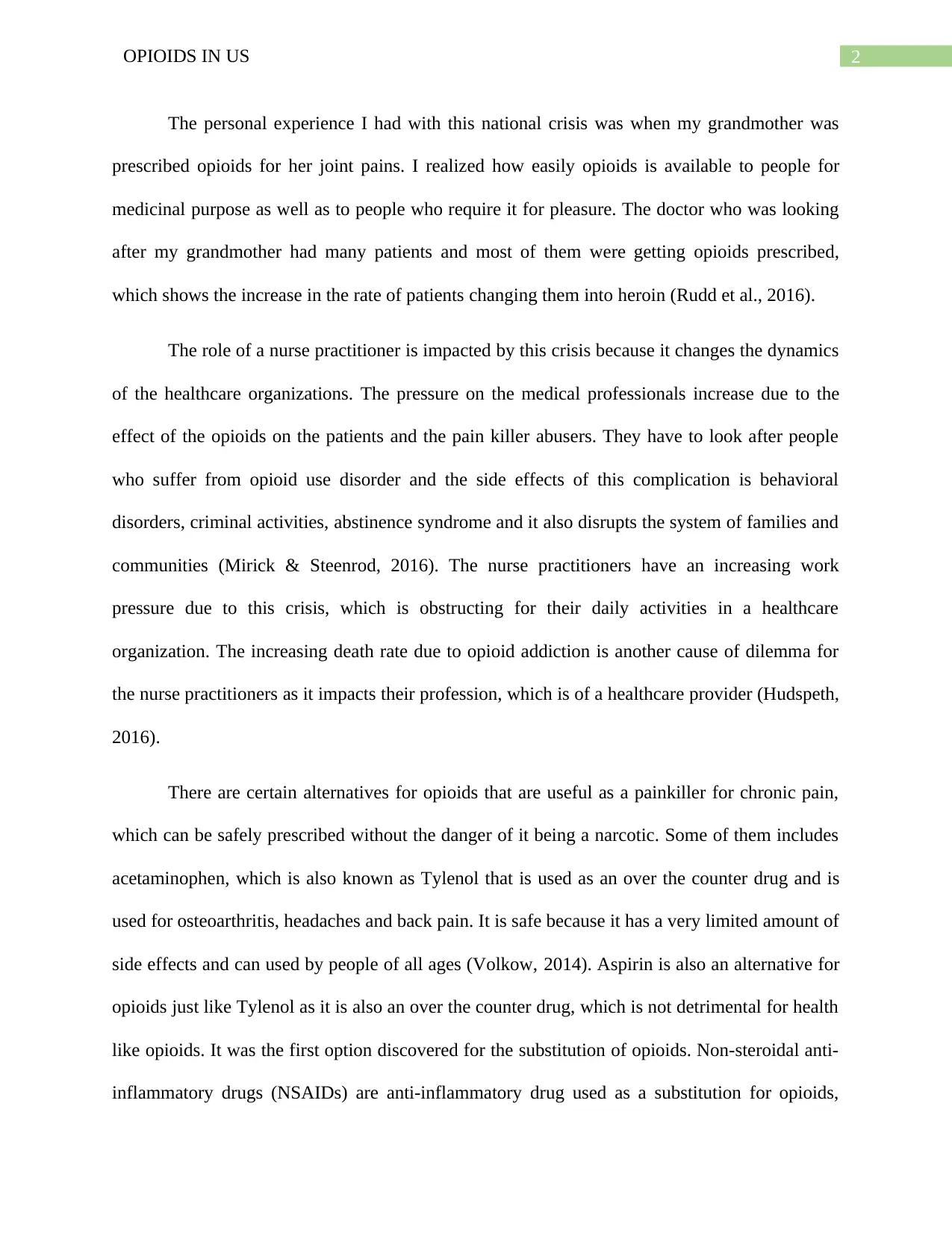
2OPIOIDS IN US
The personal experience I had with this national crisis was when my grandmother was
prescribed opioids for her joint pains. I realized how easily opioids is available to people for
medicinal purpose as well as to people who require it for pleasure. The doctor who was looking
after my grandmother had many patients and most of them were getting opioids prescribed,
which shows the increase in the rate of patients changing them into heroin (Rudd et al., 2016).
The role of a nurse practitioner is impacted by this crisis because it changes the dynamics
of the healthcare organizations. The pressure on the medical professionals increase due to the
effect of the opioids on the patients and the pain killer abusers. They have to look after people
who suffer from opioid use disorder and the side effects of this complication is behavioral
disorders, criminal activities, abstinence syndrome and it also disrupts the system of families and
communities (Mirick & Steenrod, 2016). The nurse practitioners have an increasing work
pressure due to this crisis, which is obstructing for their daily activities in a healthcare
organization. The increasing death rate due to opioid addiction is another cause of dilemma for
the nurse practitioners as it impacts their profession, which is of a healthcare provider (Hudspeth,
2016).
There are certain alternatives for opioids that are useful as a painkiller for chronic pain,
which can be safely prescribed without the danger of it being a narcotic. Some of them includes
acetaminophen, which is also known as Tylenol that is used as an over the counter drug and is
used for osteoarthritis, headaches and back pain. It is safe because it has a very limited amount of
side effects and can used by people of all ages (Volkow, 2014). Aspirin is also an alternative for
opioids just like Tylenol as it is also an over the counter drug, which is not detrimental for health
like opioids. It was the first option discovered for the substitution of opioids. Non-steroidal anti-
inflammatory drugs (NSAIDs) are anti-inflammatory drug used as a substitution for opioids,
The personal experience I had with this national crisis was when my grandmother was
prescribed opioids for her joint pains. I realized how easily opioids is available to people for
medicinal purpose as well as to people who require it for pleasure. The doctor who was looking
after my grandmother had many patients and most of them were getting opioids prescribed,
which shows the increase in the rate of patients changing them into heroin (Rudd et al., 2016).
The role of a nurse practitioner is impacted by this crisis because it changes the dynamics
of the healthcare organizations. The pressure on the medical professionals increase due to the
effect of the opioids on the patients and the pain killer abusers. They have to look after people
who suffer from opioid use disorder and the side effects of this complication is behavioral
disorders, criminal activities, abstinence syndrome and it also disrupts the system of families and
communities (Mirick & Steenrod, 2016). The nurse practitioners have an increasing work
pressure due to this crisis, which is obstructing for their daily activities in a healthcare
organization. The increasing death rate due to opioid addiction is another cause of dilemma for
the nurse practitioners as it impacts their profession, which is of a healthcare provider (Hudspeth,
2016).
There are certain alternatives for opioids that are useful as a painkiller for chronic pain,
which can be safely prescribed without the danger of it being a narcotic. Some of them includes
acetaminophen, which is also known as Tylenol that is used as an over the counter drug and is
used for osteoarthritis, headaches and back pain. It is safe because it has a very limited amount of
side effects and can used by people of all ages (Volkow, 2014). Aspirin is also an alternative for
opioids just like Tylenol as it is also an over the counter drug, which is not detrimental for health
like opioids. It was the first option discovered for the substitution of opioids. Non-steroidal anti-
inflammatory drugs (NSAIDs) are anti-inflammatory drug used as a substitution for opioids,
⊘ This is a preview!⊘
Do you want full access?
Subscribe today to unlock all pages.

Trusted by 1+ million students worldwide
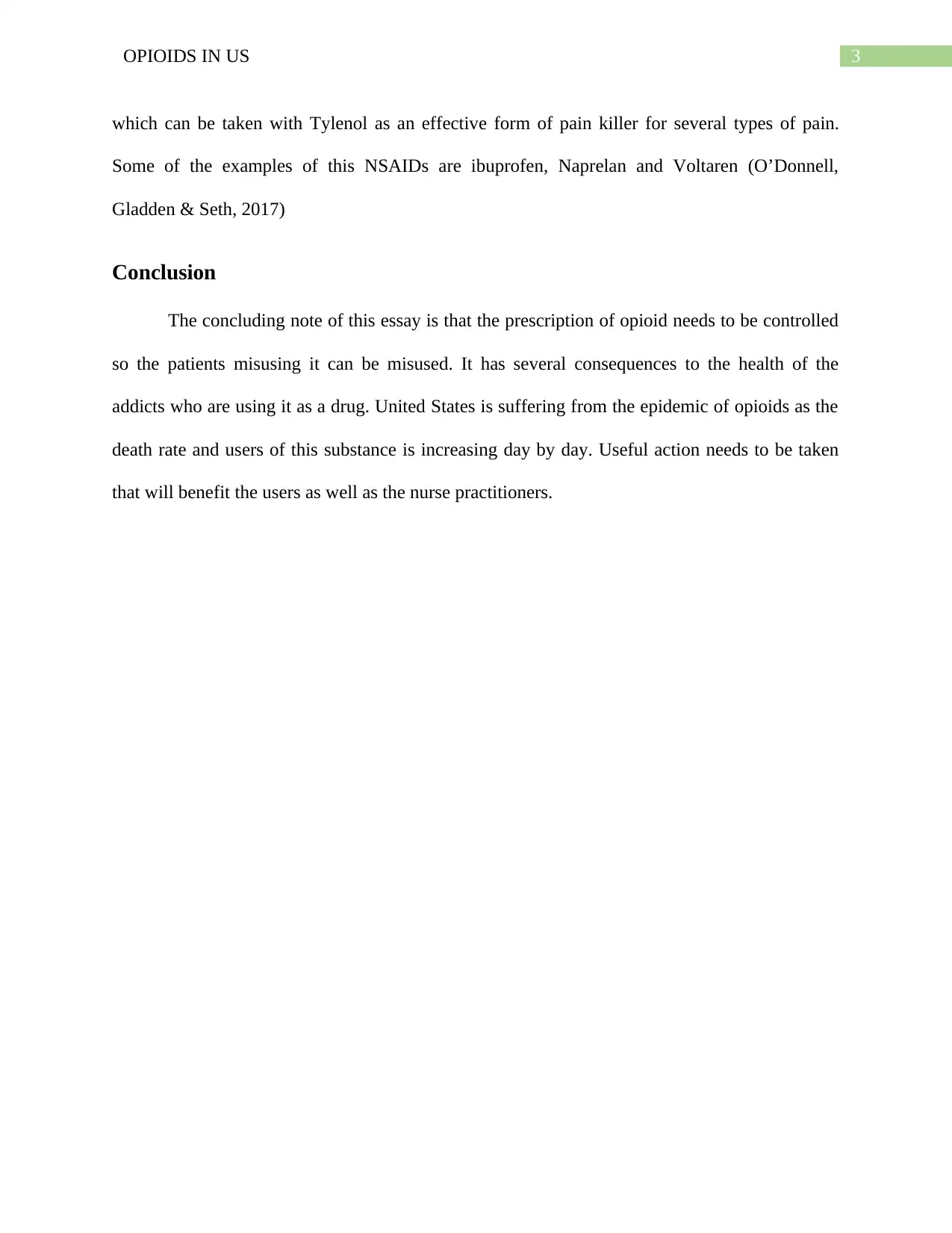
3OPIOIDS IN US
which can be taken with Tylenol as an effective form of pain killer for several types of pain.
Some of the examples of this NSAIDs are ibuprofen, Naprelan and Voltaren (O’Donnell,
Gladden & Seth, 2017)
Conclusion
The concluding note of this essay is that the prescription of opioid needs to be controlled
so the patients misusing it can be misused. It has several consequences to the health of the
addicts who are using it as a drug. United States is suffering from the epidemic of opioids as the
death rate and users of this substance is increasing day by day. Useful action needs to be taken
that will benefit the users as well as the nurse practitioners.
which can be taken with Tylenol as an effective form of pain killer for several types of pain.
Some of the examples of this NSAIDs are ibuprofen, Naprelan and Voltaren (O’Donnell,
Gladden & Seth, 2017)
Conclusion
The concluding note of this essay is that the prescription of opioid needs to be controlled
so the patients misusing it can be misused. It has several consequences to the health of the
addicts who are using it as a drug. United States is suffering from the epidemic of opioids as the
death rate and users of this substance is increasing day by day. Useful action needs to be taken
that will benefit the users as well as the nurse practitioners.
Paraphrase This Document
Need a fresh take? Get an instant paraphrase of this document with our AI Paraphraser
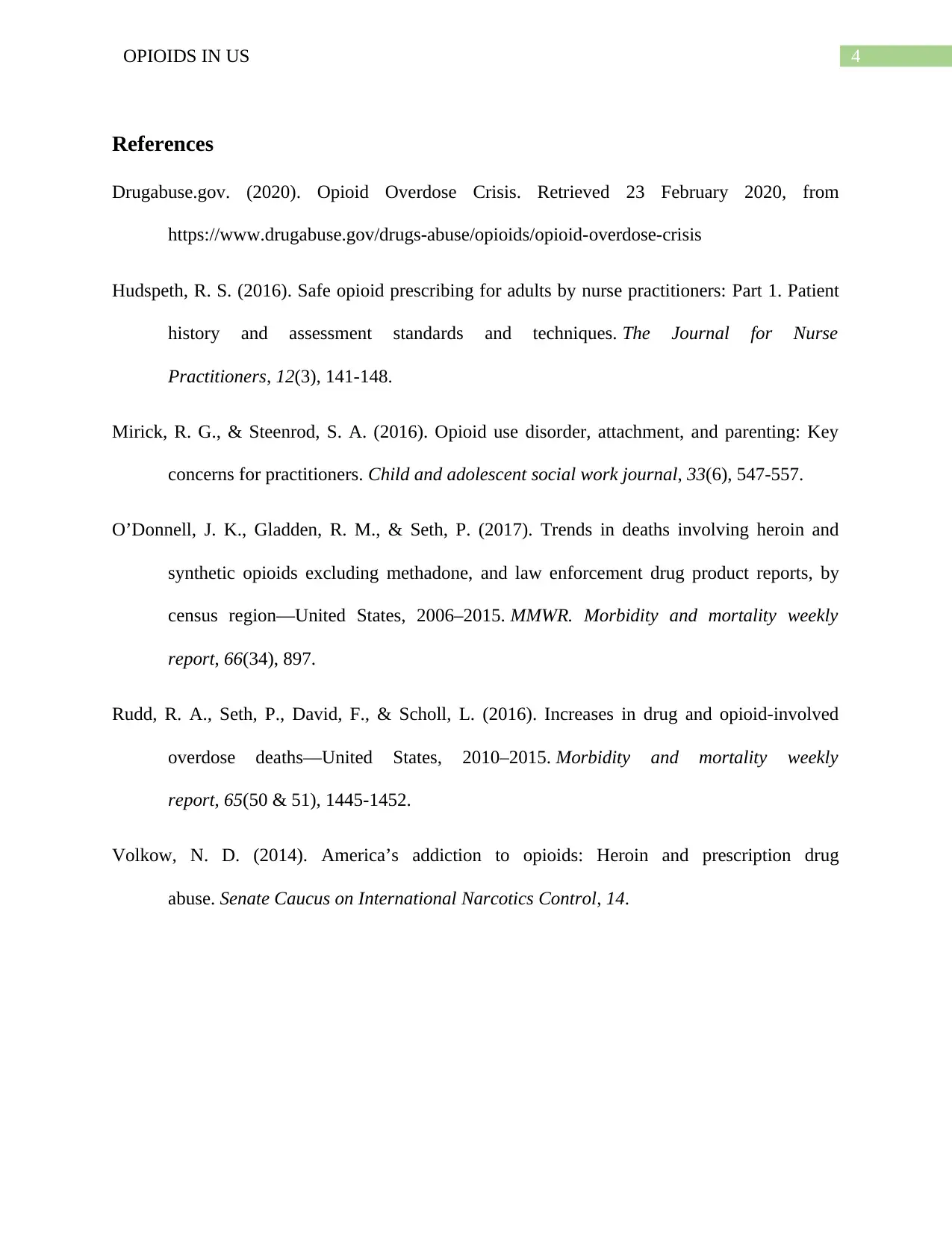
4OPIOIDS IN US
References
Drugabuse.gov. (2020). Opioid Overdose Crisis. Retrieved 23 February 2020, from
https://www.drugabuse.gov/drugs-abuse/opioids/opioid-overdose-crisis
Hudspeth, R. S. (2016). Safe opioid prescribing for adults by nurse practitioners: Part 1. Patient
history and assessment standards and techniques. The Journal for Nurse
Practitioners, 12(3), 141-148.
Mirick, R. G., & Steenrod, S. A. (2016). Opioid use disorder, attachment, and parenting: Key
concerns for practitioners. Child and adolescent social work journal, 33(6), 547-557.
O’Donnell, J. K., Gladden, R. M., & Seth, P. (2017). Trends in deaths involving heroin and
synthetic opioids excluding methadone, and law enforcement drug product reports, by
census region—United States, 2006–2015. MMWR. Morbidity and mortality weekly
report, 66(34), 897.
Rudd, R. A., Seth, P., David, F., & Scholl, L. (2016). Increases in drug and opioid-involved
overdose deaths—United States, 2010–2015. Morbidity and mortality weekly
report, 65(50 & 51), 1445-1452.
Volkow, N. D. (2014). America’s addiction to opioids: Heroin and prescription drug
abuse. Senate Caucus on International Narcotics Control, 14.
References
Drugabuse.gov. (2020). Opioid Overdose Crisis. Retrieved 23 February 2020, from
https://www.drugabuse.gov/drugs-abuse/opioids/opioid-overdose-crisis
Hudspeth, R. S. (2016). Safe opioid prescribing for adults by nurse practitioners: Part 1. Patient
history and assessment standards and techniques. The Journal for Nurse
Practitioners, 12(3), 141-148.
Mirick, R. G., & Steenrod, S. A. (2016). Opioid use disorder, attachment, and parenting: Key
concerns for practitioners. Child and adolescent social work journal, 33(6), 547-557.
O’Donnell, J. K., Gladden, R. M., & Seth, P. (2017). Trends in deaths involving heroin and
synthetic opioids excluding methadone, and law enforcement drug product reports, by
census region—United States, 2006–2015. MMWR. Morbidity and mortality weekly
report, 66(34), 897.
Rudd, R. A., Seth, P., David, F., & Scholl, L. (2016). Increases in drug and opioid-involved
overdose deaths—United States, 2010–2015. Morbidity and mortality weekly
report, 65(50 & 51), 1445-1452.
Volkow, N. D. (2014). America’s addiction to opioids: Heroin and prescription drug
abuse. Senate Caucus on International Narcotics Control, 14.
1 out of 5
Related Documents
Your All-in-One AI-Powered Toolkit for Academic Success.
+13062052269
info@desklib.com
Available 24*7 on WhatsApp / Email
![[object Object]](/_next/static/media/star-bottom.7253800d.svg)
Unlock your academic potential
Copyright © 2020–2025 A2Z Services. All Rights Reserved. Developed and managed by ZUCOL.





